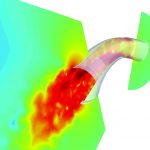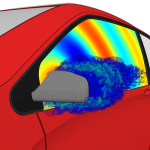NVH & Acoustics for Powertrain
FEA & CFD Based Simulation Design Analysis Virtual prototyping MultiObjective Optimization
The global demand for more eco-friendly vehicles compels automotive OEMs and suppliers to develop fuel-efficient internal combustion engines. While fuel economy measures positively impact the emission of greenhouse gasses, it inevitably affects the vehicle’s noise, vibration and harshness (NVH) and acoustic behavior.

Full system NVH simulation
Weight reduction and downsized turbocharged engines might increase torsional excitation causing low frequency driveline NVH issues when integrating the driveline into the vehicle.
In addition, new energy management systems such as cylinder deactivation systems and start-stop systems can cause new transient NVH phenomena. These new complex NVH issues need to be addressed on top of the typical engine-related NVH topics, such as engine radiation, gearbox rattle, whine, judder, clunk, fuel slosh, intake and exhaust noise, and auxiliary noises.

NVH Simulation is important, because :
Predict dynamic gear excitations
New lightweight, stiff chassis designs make structure-borne noise more important
High rotation speeds leads to higher frequency noise requiring accurate modelling and fast solutions
Greater need to balance NVH with efficiency requiring multi-attribute design optimisation
NVH & Acoustics for Powertrain
With advanced Multi-Body Dynamics (MBD) in coupled with CFD and FEA packages, Enteknograte help manufacturers save time and cost to diagnose, analyze and resolve driveline NVH and drivability issues while balancing fuel economy, drivability, NVH and ride comfort, and increasing the efficiency of the NVH development process by using advanced specialized packages.

WE WORK WITH YOU
Simulation-Based Design for better understand and improve the acoustics performance of your designs:
- Sound radiation by vibrating structures: powertrain, engine components (intake manifold and air filter, valve cover, etc.), compressors, electrical motors, loudspeakers.
- Intake and exhaust noise, including complex mufflers and silencers.
- Air conditioning units and distribution systems.
- Sound absorption inside passenger compartment of cars and trains.
- Sound propagation in complex media with mean flow or temperature gradient.
- Audio devices such as telephones, hearing aids or musical instruments.
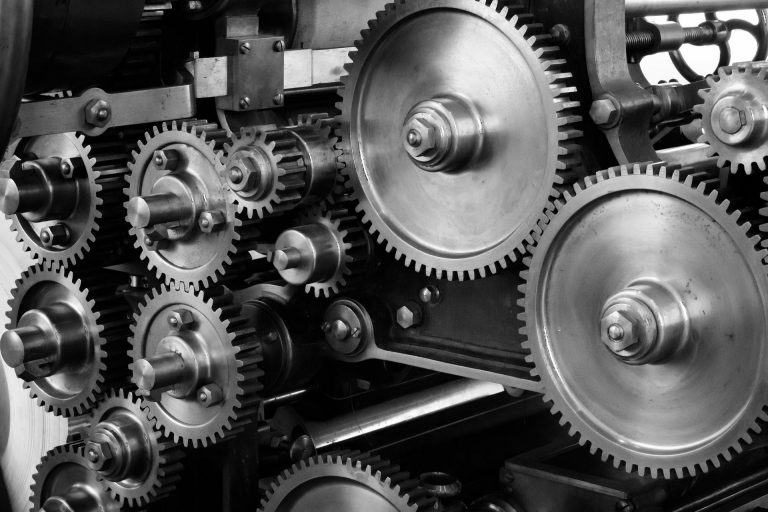
AeroAcoustics
AeroAcoustics simulation try to use advanced capabilities with couple using of CFD simulation and advanced Acoustic solvers to predict accurately and efficiently the noise generated by turbulent flows. Results from an unsteady flow simulation performed with CFD codes such as Ansys Fluent, StarCCM+, Numeca, AVL FIRE M, OpenFOAM and others are used by AeroAcoustics solver to compute aerodynamic noise sources.
With using AeroAcoustics simulation, our engineers can study the noise generated by any turbulent flow and the interactions between the aeroacoustic noise sources and a vibrating structure, absorbant materials or acoustic traps such as resonators.
Applications:
- Air conditioning modules (HVAC).
- Side mirror noise.
- Airframe noise (landing gear, trailing edge).
- Air distribution systems.
- Fan Noise
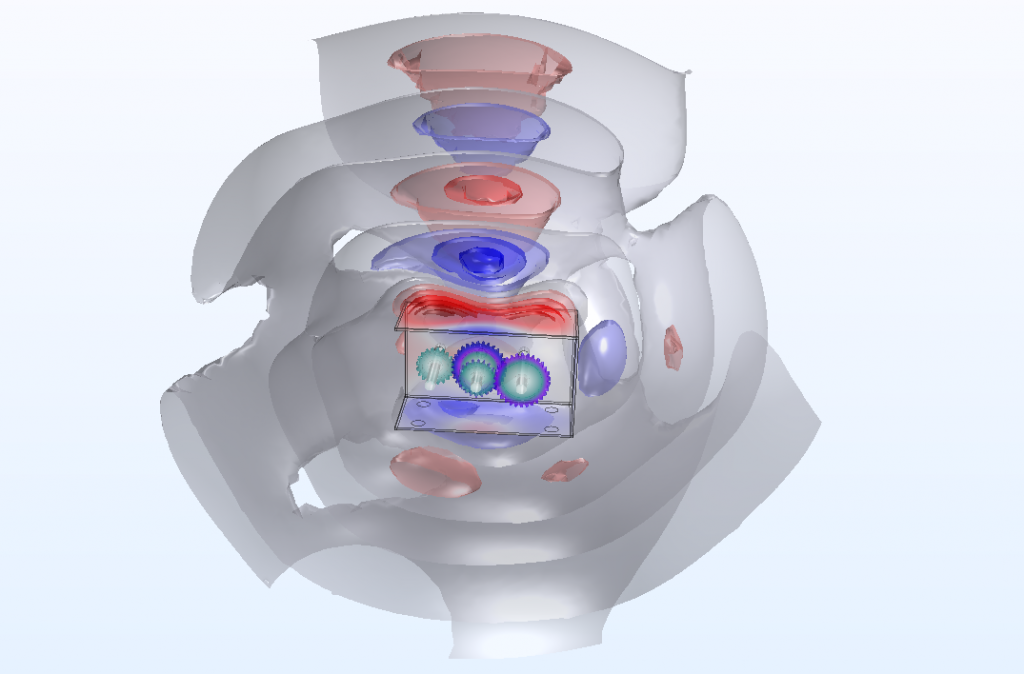
VibroAcoustics
In order to study the interaction of structural vibration with the fluid, it is necessary to model the acoustic behavior of the involved structural components including the conventional material for acoustic or visco-elastic media, porous or incompressible media, composite materials or active components like piezo-electric ceramics.
Applications:
- Automotive: Noise related problems from powertrains, intakes, exhausts, passenger compartment, trim, seats, hoses, tires, windows and windshields, audio, HVAC.
- Aerospace: Sound transmission through cockpit and fuselage, noise propagation in air distribution system, random dynamic response at take-off.
- Consumer goods: Telephones, headsets, loudspeakers, hearing aid devices, disk drives, washing machines, refrigerators, cameras


Boundary Element Acoustics
Often used for exterior acoustics problems, the boundary element method (BEM) is ideal for problems involving very complex geometry that may be a challenge to model for the FEM method. The BEM method helps simplify exterior acoustics simulation since only the outer surface mesh of the geometry is needed. This simplifies both the modeling process and reduces the degrees of freedom in the simulation model which will result in easier analysis.
Finite Element Acoustics
The finite element method (FEM) for acoustics analysis is ideal for simulating interior acoustics problems. In addition to FEM being the more efficient method in terms of solution speed, FEM acoustics lets you perform coupled vibro-acoustics analyses that take structural modes and soundproofing materials into consideration. FEM acoustics can be used to solve exterior acoustics problems as well, which is often used for noise analysis of air induction systems in powertrain.
NVH based Design and Considerations
The challenge for the NVH specialists is to support the concept and design development process by reliable recommendations just-in-time prior concept or design freeze. Enteknograte’s specialists particularly use advanced methodologies for NVH simulation and optimization:
- FEA based Powertrain
- Structural Optimization
- Optimization of Engine Dynamics based on MBD ( Multi-Body Dynamics Simulation)
- Concurrent optimization of combustion efficiency with NVH considerations
- Vehicle Interior Noise Simulation based on measurement and CAE
- Vehicle Exterior Noise Simulation with couple use of CFD and FEA solvers
- Objective Analysis of Sound Quality
- VTOL, e-VTOL and UAM – Urban Air Mobility systems noise and comfort
Aerospace Engineering: AeroAcoustics and VibroAcoustics Simulation
AeroAcoustics and VibroAcoustics in Automotive Industry
NVH & Acoustics for Hybrid & Electric Vehicles
Structural Dynamics Integrity & Vibro-Acoustics Simulation for Marine & Shipbuilding Industry
Audio Device Design: Acoustic simulation for Sound Quality Analysis in Consumer Electronic Devices
NVH ( Noise, Vibration, and Harshness ) simulation services
Finite Element Analysis of Durability and Fatigue Life
Vibration Fatigue Finite Element Simulation: Time & Frequency Domain
Hydrodynamics & HydroAcoustics simulation for AIV (Acoustic Induced Vibration)
Cavitation in Propulsion Systems
Multibody Dynamics & NVH (Noise, vibration, and harshness)
Noise, Vibration & Harshness – NVH for Electric Motors
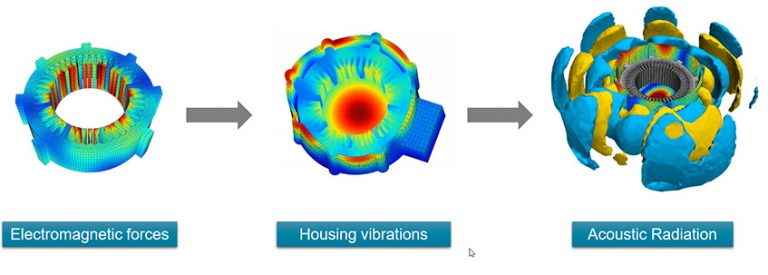

Enteknograte offers a Virtual Engineering approach with CFD and FEA tools such as MSC Cradle, Ansys Fluent, StarCCM+ for flows simulation and FEA based Codes such as ABAQUS, Ansys, Nastran and LS-Dyna, encompassing the accurate prediction of in-service loads, the performance evaluation, and the integrity assessment including the influence of manufacturing the components. Dependent of problem, we use ESI VA-one and MSC Actran as acoustics solver
Hydrodynamics CFD simulation, Coupled with FEA for FSI Analysis of Marine and offshore structures
Integrated Artificial Intelligence (AI) & Machine Learning - Deep Learning with CFD & FEA Simulation
Seat Design: Finite Element and CFD Simulation for Static & Dynamic Comfort, Whiplash, Acoustic & Thermal Comfort, Crash Test
1D/3D Coupled Simulation and Co-Simulation: Detailed Chemistry & Multiphase Flow Modeling with 1D Modeling
Aerodynamics Simulation: Coupling CFD with MBD, FEA and 1D-System Simulation
eVTOL (Electric Vertical Take-Off and Landing) & UAM (Urban Air Mobility)
Full Vehicle MultiBody Dynamics Simulation: Car Ride, Driveline, Engine and Tire MBD
Robots Dynamics & Performance Assessment: Coupled MBD & FEA Simulation-Based Design
Heat Transfer and Thermal Analysis: Fluid-Structure Interaction with Coupled CFD and Finite Element Based Simulation
Aerodynamic Noise Simulation
Acoustics and Vibration: FEA and CFD for AeroAcoustics, VibroAcoustics and NVH Analysis
Electromagnetic Multiphysics




